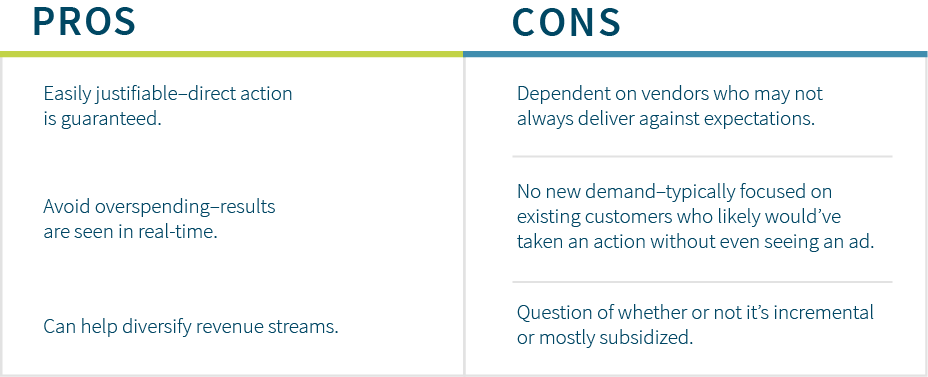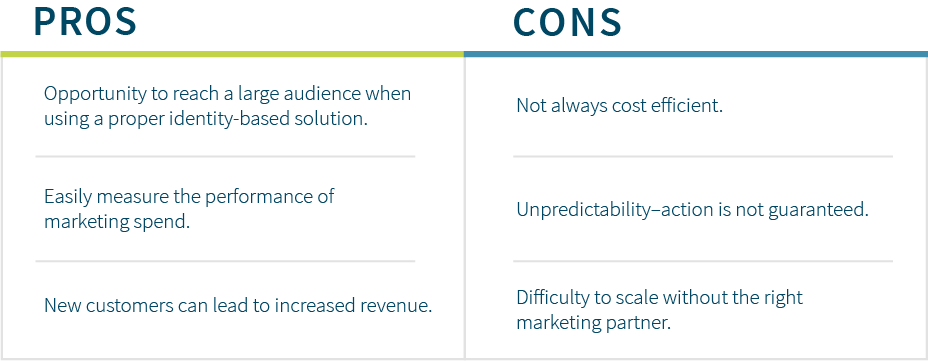
Articles | March 25, 2021 | 3 min read
Customer Acquisition vs. Performance Marketing
Marketers are facing a measurement problem. Right now, less than 40% of companies (39% to be exact) can easily ascertain the effectiveness of their marketing. In this blog, you’ll get a glimpse at how measurement works for two of the most popular marketing strategies out there—Customer Acquisition versus Performance Marketing.
Specifically, you’ll see which of these two strategies is better positioned to solve the measurement problem that’s plaguing enterprise marketers.
With Performance Marketing (sometimes known as Affiliate Marketing), marketers or advertisers only pay for specific actions—a click, a touch, a conversion, etc.—in a specific timeframe.
It’s an approach to marketing that comes with a quick, clean, simple form measurement.
Unfortunately, the information yielded by measuring a Performance Marketing strategy isn’t always useful because it’s overly reliant on last-touch attribution. This matters as there are three major challenges when it comes to last-touch attribution:
Since the consumer’s buying journey extends across various devices, browsers, and sessions, last-touch attribution often assigns too much credit to the final touch, and too little credit to all other advertising touches.
Last-click attribution fails to recognize that people who click and convert are very low in the sales funnel. As such, some will likely convert without any exposure to advertising. This ultimately means the acquisition cost will not reflect a true cost.
Last-touch attribution limits marketing campaign costs at the expense of business growth.

The primary goal of a Customer Acquisition strategy is to (as the name suggests) acquire a new customer. In other words, drive the purchase of a product or service from a net-new buyer.
Solving for customer acquisition is a huge challenge for many marketers as it’s almost impossible for a company to hit its given growth goals if marketers don’t bring net-new customers in the door.
But the reality is that marketers’ appetite for growth exceeds what existing customers alone can offer. Marketers can’t rely solely on tactics like Performance Marketing to meet growth-related KPIs as those customers likely would’ve taken an action regardless of their exposure to an ad.
Unlike Performance Marketing, however, measurement for Customer Acquisition is more complex. Finding the right balance between cost effectiveness, scalability, and predictability can be a challenge, yet all are needed to properly measure the true impact of customer acquisition. Similarly, many Customer Acquisition campaigns leverage traditional metrics such as Return on Ad Spend (ROAS) that don’t paint a clear picture of revenue and results. It’s only when marketers leverage incrementality measurement can they see the true value of their customer acquisition marketing efforts.

While Performance Marketing seems like a valuable strategy on paper since action is guaranteed, its common KPIs (clicks, signups, conversions, etc.) don’t always provide proper insight into marketing effectiveness. With a heavy reliance on last-touch attribution, this approach can be inaccurate, non-reflective of true acquisition costs, and impair long-term growth. Marketers need a data-driven approach with more sophisticated measurement capabilities. With the right partner, customer acquisition can help solve this challenge by activating knowledge and media at the individual level and ensure the right customers are being reached at the most opportunistic moment.
In order to be successful, a customer acquisition strategy must be cost-effective, scalable, and predictable period to period, month over month. Moreover, it should place emphasis on incrementality measurement to paint a clear picture of the return generated by your marketing efforts. The Zeta Marketing Platform helps marketers solve these challenges with independent technology that is data-intensive and identity-based to deliver against the higher standard of customer acquisition. By activating media, holding exposures, and measuring the impact of your marketing efforts at the individual level, your brand can see measurable results that drive business growth.
Specifically, you’ll see which of these two strategies is better positioned to solve the measurement problem that’s plaguing enterprise marketers.
Performance Marketing: A Refresher
With Performance Marketing (sometimes known as Affiliate Marketing), marketers or advertisers only pay for specific actions—a click, a touch, a conversion, etc.—in a specific timeframe.
It’s an approach to marketing that comes with a quick, clean, simple form measurement.
Unfortunately, the information yielded by measuring a Performance Marketing strategy isn’t always useful because it’s overly reliant on last-touch attribution. This matters as there are three major challenges when it comes to last-touch attribution:
- Inaccuracy
Since the consumer’s buying journey extends across various devices, browsers, and sessions, last-touch attribution often assigns too much credit to the final touch, and too little credit to all other advertising touches.
- Veiled acquisition cost
Last-click attribution fails to recognize that people who click and convert are very low in the sales funnel. As such, some will likely convert without any exposure to advertising. This ultimately means the acquisition cost will not reflect a true cost.
- Impaired long-term growth
Last-touch attribution limits marketing campaign costs at the expense of business growth.

Customer Acquisition: A Refresher
The primary goal of a Customer Acquisition strategy is to (as the name suggests) acquire a new customer. In other words, drive the purchase of a product or service from a net-new buyer.
Solving for customer acquisition is a huge challenge for many marketers as it’s almost impossible for a company to hit its given growth goals if marketers don’t bring net-new customers in the door.
But the reality is that marketers’ appetite for growth exceeds what existing customers alone can offer. Marketers can’t rely solely on tactics like Performance Marketing to meet growth-related KPIs as those customers likely would’ve taken an action regardless of their exposure to an ad.
Unlike Performance Marketing, however, measurement for Customer Acquisition is more complex. Finding the right balance between cost effectiveness, scalability, and predictability can be a challenge, yet all are needed to properly measure the true impact of customer acquisition. Similarly, many Customer Acquisition campaigns leverage traditional metrics such as Return on Ad Spend (ROAS) that don’t paint a clear picture of revenue and results. It’s only when marketers leverage incrementality measurement can they see the true value of their customer acquisition marketing efforts.
The Pros. The Cons.

The Conclusion: Which Approach Solves the Measurement Problem the Best?
While Performance Marketing seems like a valuable strategy on paper since action is guaranteed, its common KPIs (clicks, signups, conversions, etc.) don’t always provide proper insight into marketing effectiveness. With a heavy reliance on last-touch attribution, this approach can be inaccurate, non-reflective of true acquisition costs, and impair long-term growth. Marketers need a data-driven approach with more sophisticated measurement capabilities. With the right partner, customer acquisition can help solve this challenge by activating knowledge and media at the individual level and ensure the right customers are being reached at the most opportunistic moment.
In order to be successful, a customer acquisition strategy must be cost-effective, scalable, and predictable period to period, month over month. Moreover, it should place emphasis on incrementality measurement to paint a clear picture of the return generated by your marketing efforts. The Zeta Marketing Platform helps marketers solve these challenges with independent technology that is data-intensive and identity-based to deliver against the higher standard of customer acquisition. By activating media, holding exposures, and measuring the impact of your marketing efforts at the individual level, your brand can see measurable results that drive business growth.


